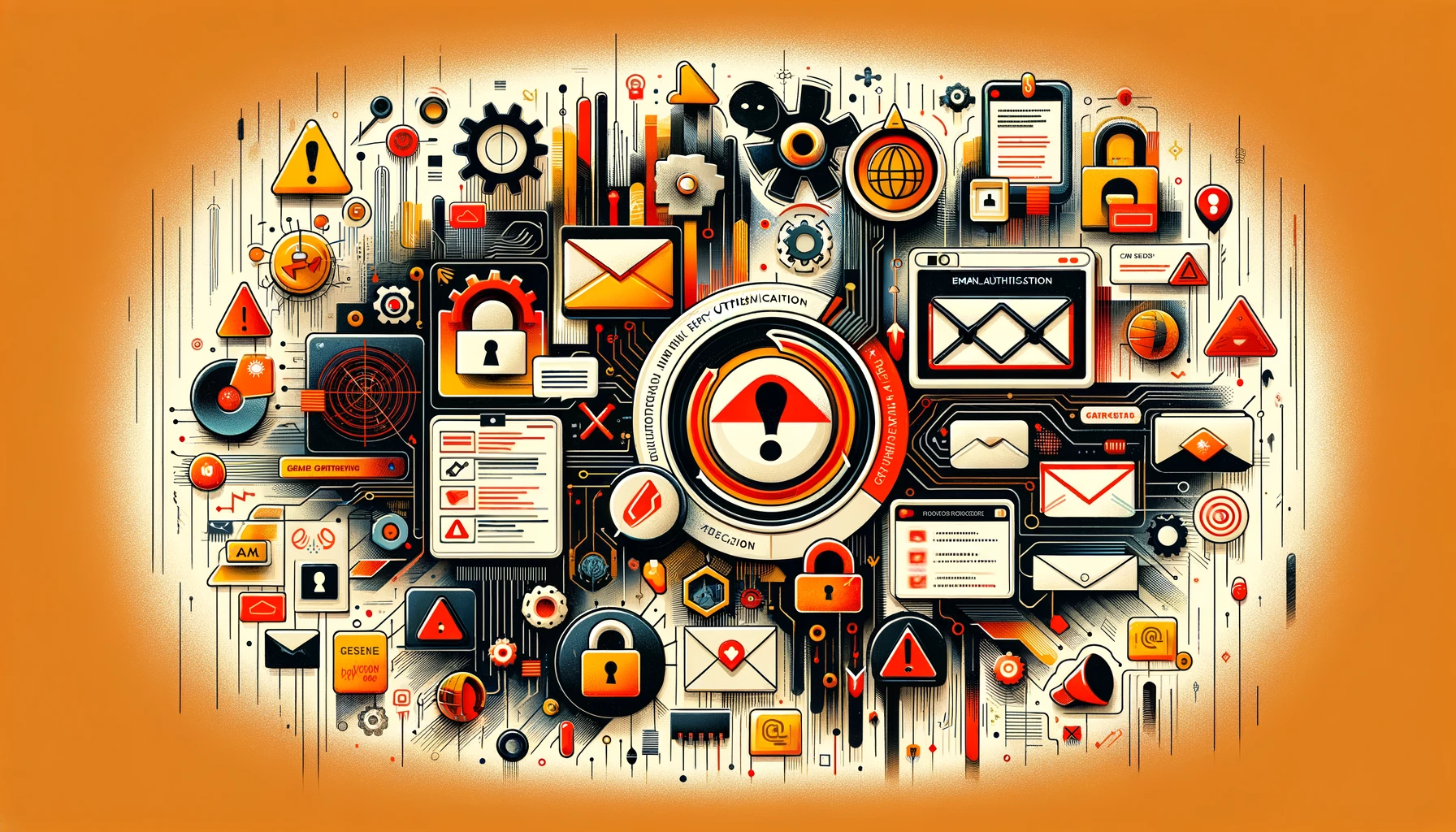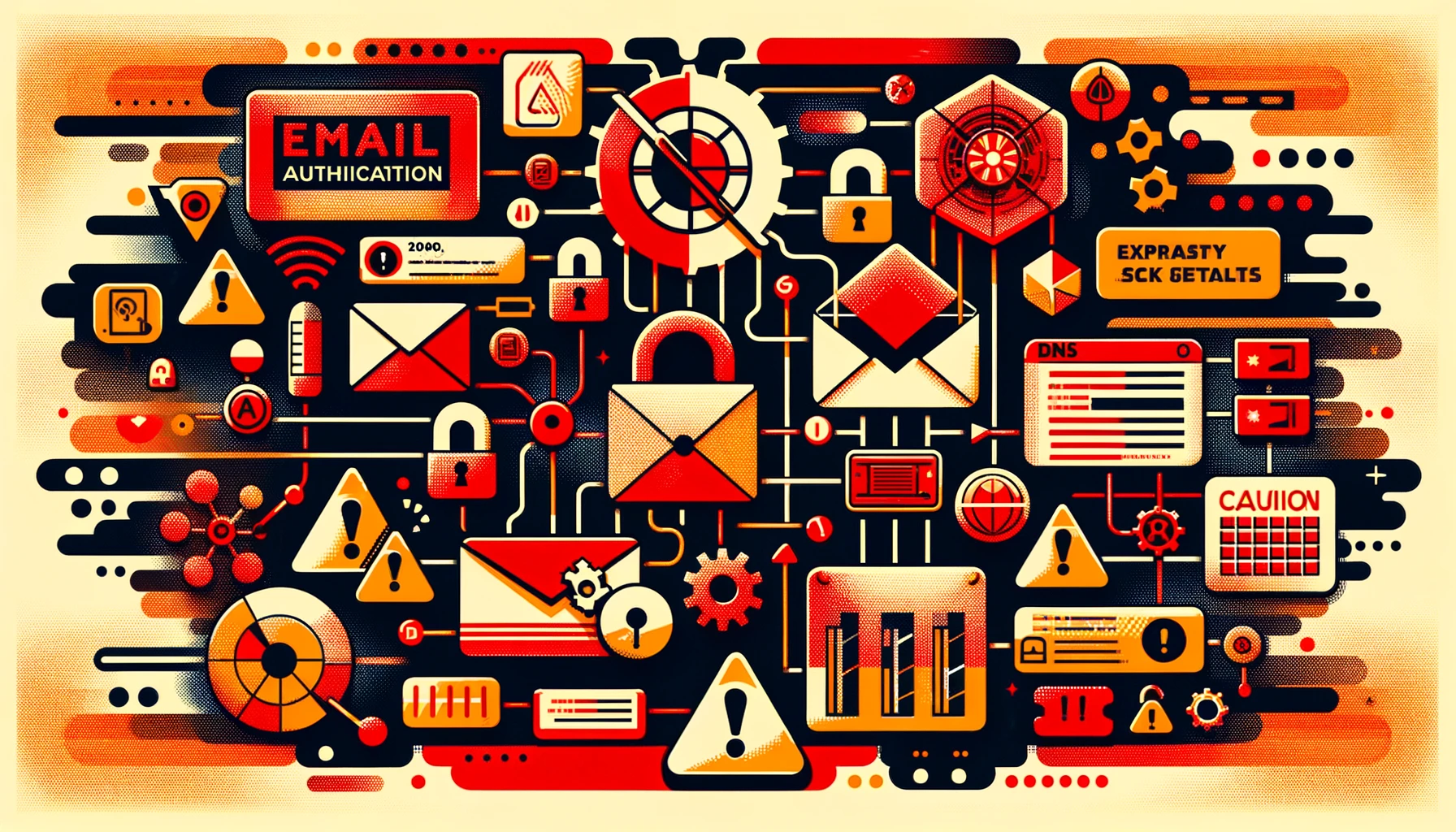Top Reasons Why Email Authentication Fails
Understanding Email Authentication
Email authentication is a critical framework that ensures the integrity and authenticity of email messages. It guards against phishing, spam, and impersonation attacks.
Importance of SPF, DKIM, and DMARC
SPF (Sender Policy Framework), DKIM (DomainKeys Identified Mail), and DMARC (Domain-based Message Authentication, Reporting, and Conformance) are pillars of email authentication. SPF prevents sender address forgery, DKIM provides a cryptographic signature to verify message content integrity, and DMARC ties the SPF and DKIM authentication results to the domain owner's policy, enhancing email trustworthiness and combating phishing.
Role of Domain and Sender in Email Authentication
The domain and sender play a pivotal role in email authentication. The domain indicates the origin of the email message, serving as a reference point for SPF, DKIM, and DMARC checks. The sender's reputation, authenticated through these protocols, influences email deliverability and trust among recipients.
Email Authentication Protocols 101
Email authentication protocols like SPF, DKIM, and DMARC are essential tools in the fight against email fraud. They authenticate the sender's domain name, ensuring that the email message originates from a legitimate source and has not been tampered with during transit.
How to Authenticate Your Email
To authenticate your email, set up SPF and DKIM records in your DNS. SPF authorizes email servers to send emails on your domain's behalf, while DKIM adds a digital signature to each email, ensuring its content remains unchanged. Implementing DMARC then provides further protection by specifying how receivers should handle emails failing SPF or DKIM checks.
Common Issues with SPF and DKIM
Failed SPF Records
Failed SPF records occur when an email is sent from a server not authorized by the domain's SPF record. This mismatch can lead to email rejection or marking as spam, harming email deliverability. Ensuring accurate SPF records that reflect all legitimate email sources is crucial.
Troubleshooting DKIM Authentication
Troubleshooting DKIM authentication involves checking the DKIM signature and record setup. Common issues include incorrect DNS records, missing or invalid DKIM signatures, and misconfigurations in the email server or email service provider settings. Ensuring correct DKIM record entries and alignment with the sending domain is essential.
SPF vs DKIM: Choosing the Right Authentication Method
Choosing between SPF and DKIM is not an either/or scenario; both are complementary authentication methods. SPF validates the sending server, while DKIM verifies the message integrity. Using both SPF and DKIM provides a robust defense against email spoofing and phishing.
Implementing SPF and DKIM for Different Email Clients
Implementing SPF and DKIM varies slightly across different email clients but generally involves creating DNS records. For SPF, you add a TXT record to your DNS settings to list authorized sending servers. DKIM requires generating a public/private key pair, publishing the public key as a DNS record, and configuring your email server or service to sign outgoing emails with the private key.
Authentication Checks and Email Deliverability
Authentication checks significantly impact email deliverability. Emails passing SPF, DKIM, and DMARC verifications are more likely to reach the inbox, as they are deemed safe by email providers. These protocols are essential tools for domain owners and email senders to ensure their communications are trusted and delivered successfully.
Understanding DMARC and its Impact on Email Authentication
DMARC stands as a vital advancement in email authentication, streamlining the verification process and significantly enhancing security against fraud and misuse.
Verifying Sender and Domain with DMARC
DMARC (Domain-based Message Authentication, Reporting, and Conformance) revolutionizes how email authenticity is verified, intertwining with SPF (Sender Policy Framework) and DKIM (DomainKeys Identified Mail) to authenticate the sender’s email address and ensure the email’s integrity. By leveraging the domain name system (DNS) for validation, DMARC provides a robust method to protect against phishing emails, ensuring that only authorized senders are allowed to send email from your domain.
Enhancing Authentication with DMARC
Enhancing email authentication with DMARC involves setting up email authentication records in the DNS. DMARC policies allow domain owners to specify how receiving email servers should treat emails that don’t pass SPF or DKIM checks. This proactive stance fortifies domain authentication, elevating the authentication status of sent emails and protecting email recipients from potential fraud.
Implementing DMARC to Prevent Phishing and Spam
Implementing DMARC is a critical step for organizations to prevent phishing and spam. It not only verifies that an email was authorized to send from the domain but also instructs receiving email servers on how to handle emails that fail authentication checks. This level of sender authentication significantly reduces the risk of phishing email reaching end-users, thus safeguarding the brand’s reputation and enhancing email deliverability.
DMARC Authentication Methods 101
DMARC authentication methods utilize email authentication protocols like SPF and DKIM, providing a framework for email validation. By checking the email header against the authentication information published in the DNS, DMARC ensures strong email authentication, confirming the email was sent from an allowed domain and aligns with the domain's policy on handling emails that either pass or fail SPF and DKIM checks.
Validating Sender’s Email Address with DMARC
Validating a sender's email address with DMARC involves a meticulous process where DMARC records are used to verify that an email complies with the policies set by the domain owner. This validation process enhances trust in email communication, ensuring that only emails passing SPF and DKIM authentication are delivered, thereby protecting against unauthorized use of the domain for email.
Best Practices for Strong Email Authentication
Email Authentication Tools and Technologies
Email authentication tools and technologies are essential for businesses and email marketers to secure their email campaigns. Utilizing authentication standards like SPF, DKIM, and DMARC, alongside advanced authentication technologies, ensures that emails are verified for authenticity before reaching the recipient. These tools are pivotal in maintaining the integrity of email marketing efforts, safeguarding against spam and phishing attacks.
Utilizing Public and Private Keys for Authentication
The utilization of public and private keys plays a crucial role in email authentication methods, particularly in DKIM. The private key is used to sign the email sent, while the public key, published in the DNS, is used by the receiving email server to verify the signature. This dual-key approach ensures that the email has not been tampered with and originates from a legitimate source.
Authentication Standards and Protocols for Email Marketing
Authentication standards and protocols, such as SPF, DKIM, and DMARC, are foundational for securing email marketing campaigns. These protocols authenticate your email, ensuring that the sender’s email address is authorized and the content remains intact, thus preventing email spoofing and enhancing email delivery to intended recipients.
Domain Authentication and Its Role in Email Security
Domain authentication safeguards email security by verifying that emails sent from a domain are authorized. By implementing SPF and DMARC records in the domain name system (DNS), domain owners can specify which email servers are permitted to send emails on their behalf, significantly reducing the likelihood of their domain being used for email fraud.
Ensuring Legitimate Email with Strong Authentication
Ensuring that an email is legitimate involves a comprehensive approach to authentication. Strong email authentication, achieved through the diligent setup and maintenance of SPF, DKIM, and DMARC records, guarantees that emails are authenticated at multiple levels. This multi-faceted authentication helps in maintaining the integrity of email communication, ensuring that only authenticated, legitimate emails reach their intended recipients, thereby enhancing overall email security and trustworthiness.
How to Check and Improve Your Email Authentication Status
Improving your email authentication status is crucial for ensuring your emails reach the intended inboxes, safeguarding against forgery, and enhancing overall email deliverability.
Validating SPF and DKIM Records
Validating SPF and DKIM records is a vital step in confirming that your email authentication methods are correctly set up. SPF is used to specify which mail servers are authorized to send email on behalf of your domain, while DKIM provides a digital signature that verifies the email content has not been tampered with. Use online tools provided by many email service providers to check your SPF and DKIM records. Regular review and updating of these records ensure they reflect current email sending practices, thus maintaining valid email authentication.
Utilizing Authentication Technology for Email Authentication
Utilizing advanced authentication technology is key to robust email authentication. Technologies such as SPF, DKIM, and DMARC work collectively to verify the identity of an email sender and the integrity of the message sent. Implementing these technologies helps in ensuring that only authenticated emails are accepted by email inboxes, significantly reducing the chances of email forgery and improving email deliverability.
Checking Email Headers for Authentication Status
Email headers contain valuable information about the authentication status of an email. By examining the headers, you can determine whether the email has passed SPF, DKIM, and DMARC checks. This insight allows senders to troubleshoot and rectify any issues that might prevent successful authentication, ensuring that authentication protocols are working correctly and that receiving email servers are more likely to accept the email.
Ensuring Successful Authentication for Receiving Email Servers
For receiving email servers to successfully authenticate and accept emails, senders must correctly implement SPF, DKIM, and DMARC protocols. Ensuring successful authentication involves regularly checking that these records are accurate and reflect current email sending practices. Correct implementation of email authentication not only improves email deliverability but also builds trust with email service providers and recipients.
Guidelines for Email Marketers to Enhance Authentication
Email marketers can enhance authentication by adhering to several guidelines: First, ensure that SPF, DKIM, and DMARC are correctly set up and validated. Regular monitoring of authentication results helps in identifying and addressing any issues promptly. Additionally, using DMARC reports can provide insights into authentication successes and failures, helping to refine and improve email authentication practices. Ultimately, effective email authentication verifies the sender's identity and ensures emails are more likely to reach their intended recipients, boosting engagement and trust.
Improving email authentication is not just about implementing the necessary protocols but also about regular monitoring and adjustment based on authentication results and changes in email sending practices. By following these guidelines, email marketers and senders can significantly enhance the reliability and effectiveness of their email communications, ensuring their messages are delivered to the recipient's inbox as intended.
Inagiffy: Your Ultimate Newsletter Marketing Partner
In today's crowded digital landscape, building genuine, lasting connections with your audience is more crucial than ever.
Enter Inagiffy – a premier newsletter marketing agency that understands the transformative power of well-crafted newsletters. We're not just about sending out emails; we're about curating stories, insights, and value that resonate deeply with your audience.
Our end-to-end solutions ensure that from ideation to delivery, every newsletter reflects your brand's essence and speaks directly to your audience's needs and aspirations. Let Inagiffy empower your brand, forging authentic relationships and driving engagement through the potent medium of newsletters.
Dive into the future of meaningful communication with us and watch your audience grow, engage, and thrive.
FAQs
What is an email authentication method?
An email authentication method is a set of protocols used to verify that an email message is sent from a legitimate source and has not been altered in transit. It helps protect against phishing, spoofing, and spam, enhancing email security and deliverability.
What is the email authentication program?
The email authentication program refers to a comprehensive strategy or system implemented by organizations to apply and manage email authentication methods like SPF, DKIM, and DMARC. It ensures emails are authenticated, thereby improving trust and deliverability.
What are the three major email authentication protocols?
The three major email authentication protocols are Sender Policy Framework (SPF), DomainKeys Identified Mail (DKIM), and Domain-based Message Authentication, Reporting, and Conformance (DMARC). These protocols work together to authenticate the sender's identity and the integrity of the message.
What is email server authentication?
Email server authentication involves verifying the identity of the server that sends an email to ensure it's authorized by the domain owner. This process uses protocols such as SPF and DKIM to prevent unauthorized use of the domain and protect against spam and phishing attacks.


Comments
Your comment has been submitted successfully!